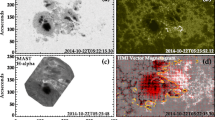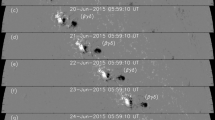Abstract
We present a comparison of the Solar Dynamics Observatory (SDO) analysis of NOAA Active Region (AR) 11158 and numerical simulations of flux-tube emergence, aiming to investigate the formation process of this flare-productive AR. First, we use SDO/Helioseismic and Magnetic Imager (HMI) magnetograms to investigate the photospheric evolution and Atmospheric Imaging Assembly (AIA) data to analyze the relevant coronal structures. Key features of this quadrupolar region are a long sheared polarity inversion line (PIL) in the central δ-sunspots and a coronal arcade above the PIL. We find that these features are responsible for the production of intense flares, including an X2.2-class event. Based on the observations, we then propose two possible models for the creation of AR 11158 and conduct flux-emergence simulations of the two cases to reproduce this AR. Case 1 is the emergence of a single flux tube, which is split into two in the convection zone and emerges at two locations, while Case 2 is the emergence of two isolated but neighboring tubes. We find that, in Case 1, a sheared PIL and a coronal arcade are created in the middle of the region, which agrees with the AR 11158 observation. However, Case 2 never builds a clear PIL, which deviates from the observation. Therefore, we conclude that the flare-productive AR 11158 is, between the two cases, more likely to be created from a single split emerging flux than from two independent flux bundles.










Similar content being viewed by others
References
Archontis, V., Hood, A.W., Brady, C.: 2007, Emergence and interaction of twisted flux tubes in the Sun. Astron. Astrophys. 466, 367 – 376. 10.1051/0004-6361:20066508 . 2007A%26A...466..367A .
Archontis, V., Hood, A.W.: 2009, Formation of Ellerman bombs due to 3D flux emergence. Astron. Astrophys. 508, 1469 – 1483. 10.1051/0004-6361/200912455 . 2009A%26A...508.1469A .
Archontis, V., Hood, A.W., Tsinganos, K.: 2013, The emergence of weakly twisted magnetic fields in the Sun. Astrophys. J. 778, 42. 10.1088/0004-637X/778/1/42 . 2013ApJ...778...42A .
Archontis, V., Tsinganos, K., Gontikakis, C.: 2010, Recurrent solar jets in active regions. Astron. Astrophys. 512, L2. 10.1051/0004-6361/200913752 . 2010A%26A...512L...2A .
Bamba, Y., Kusano, K., Yamamoto, T.T., Okamoto, T.J.: 2013, Study on the triggering process of solar flares based on Hinode/SOT observations. Astrophys. J. 778, 48. 10.1088/0004-637X/778/1/48 . 2013ApJ...778...48B .
Chintzoglou, G., Zhang, J.: 2013, Reconstructing the subsurface three-dimensional magnetic structure of a solar active region using SDO/HMI observations. Astrophys. J. Lett. 764, L3. 10.1088/2041-8205/764/1/L3 . 2013ApJ...764L...3C .
D’Silva, S., Choudhuri, A.R.: 1993, A theoretical model for tilts of bipolar magnetic regions. Astron. Astrophys. 272, 621. 1993A%26A...272..621D .
Fan, Y.: 2009, Magnetic fields in the solar convection zone. Living Rev. Solar Phys. 6, 4. 10.12942/lrsp-2009-4 . 2009LRSP....6....4F .
Fan, Y., Zweibel, E.G., Lantz, S.R.: 1998, Two-dimensional simulations of buoyantly rising, interacting magnetic flux tubes. Astrophys. J. 493, 480. 10.1086/305122 . 1998ApJ...493..480F .
Fan, Y., Zweibel, E.G., Linton, M.G., Fisher, G.H.: 1998, The rise of kink-unstable magnetic flux tubes in the solar convection zone. Astrophys. J. Lett. 505, L59. 10.1086/311597 . 1998ApJ...505L..59F .
Gontikakis, C., Archontis, V., Tsinganos, K.: 2009, Observations and 3D MHD simulations of a solar active region jet. Astron. Astrophys. 506, L45 – L48. 10.1051/0004-6361/200913026 . 2009A%26A...506L..45G .
Hagyard, M.J., Teuber, D., West, E.A., Smith, J.B.: 1984, A quantitative study relating observed shear in photospheric magnetic fields to repeated flaring. Solar Phys. 91, 115 – 126. 10.1007/BF00213618 . 1984SoPh...91..115H .
Hale, G.E., Ellerman, F., Nicholson, S.B., Joy, A.H.: 1919, The magnetic polarity of sunspots. Astrophys. J. 49, 153. 10.1086/142452 . 1919ApJ....49..153H .
Ilonidis, S., Zhao, J., Kosovichev, A.: 2011, Detection of emerging sunspot regions in the solar interior. Science 333. 10.1126/science.1206253 . 2011Sci...333..993I .
Isobe, H., Tripathi, D., Archontis, V.: 2007, Ellerman bombs and jets associated with resistive flux emergence. Astrophys. J. Lett. 657, L53 – L56. 10.1086/512969 . 2007ApJ...657L..53I .
Kusano, K., Bamba, Y., Yamamoto, T.T., Iida, Y., Toriumi, S., Asai, A.: 2012, Magnetic field structures triggering solar flares and coronal mass ejections. Astrophys. J. 760, 31. 10.1088/0004-637X/760/1/31 . 2012ApJ...760...31K .
Lemen, J.R., Title, A.M., Akin, D.J., Boerner, P.F., Chou, C., Drake, J.F., Duncan, D.W., Edwards, C.G., Friedlaender, F.M., Heyman, G.F., Hurlburt, N.E., Katz, N.L., Kushner, G.D., Levay, M., Lindgren, R.W., Mathur, D.P., McFeaters, E.L., Mitchell, S., Rehse, R.A., Schrijver, C.J., Springer, L.A., Stern, R.A., Tarbell, T.D., Wuelser, J.-P., Wolfson, C.J., Yanari, C., Bookbinder, J.A., Cheimets, P.N., Caldwell, D., Deluca, E.E., Gates, R., Golub, L., Park, S., Podgorski, W.A., Bush, R.I., Scherrer, P.H., Gummin, M.A., Smith, P., Auker, G., Jerram, P., Pool, P., Soufli, R., Windt, D.L., Beardsley, S., Clapp, M., Lang, J., Waltham, N.: 2012, The Atmospheric Imaging Assembly (AIA) on the Solar Dynamics Observatory (SDO). Solar Phys. 275, 17 – 40. 10.1007/s11207-011-9776-8 . 2012SoPh..275...17L .
Linton, M.G., Dahlburg, R.B., Antiochos, S.K.: 2001, Reconnection of twisted flux tubes as a function of contact angle. Astrophys. J. 553, 905 – 921. 10.1086/320974 . 2001ApJ...553..905L .
Linton, M.G., Longcope, D.W., Fisher, G.H.: 1996, The helical kink instability of isolated, twisted magnetic flux tubes. Astrophys. J. 469, 954. 10.1086/177842 . 1996ApJ...469..954L .
Liu, C., Deng, N., Liu, R., Lee, J., Wiegelmann, T., Jing, J., Xu, Y., Wang, S., Wang, H.: 2012, Rapid changes of photospheric magnetic field after tether-cutting reconnection and magnetic implosion. Astrophys. J. Lett. 745, L4. 10.1088/2041-8205/745/1/L4 . 2012ApJ...745L...4L .
Magara, T.: 2007, A possible structure of the magnetic field in solar filaments obtained by flux emergence. Publ. Astron. Soc. Japan 59, L51. 2007PASJ...59L..51M .
Matsumoto, R., Tajima, T., Chou, W., Okubo, A., Shibata, K.: 1998, Formation of a kinked alignment of solar active regions. Astrophys. J. Lett. 493, L43. 10.1086/311116 . 1998ApJ...493L..43M .
Murray, M.J., Hood, A.W.: 2007, Simple emergence structures from complex magnetic fields. Astron. Astrophys. 470, 709 – 719. 10.1051/0004-6361:20077251 . 2007A%26A...470..709M .
Pesnell, W.D., Thompson, B.J., Chamberlin, P.C.: 2012, The Solar Dynamics Observatory (SDO). Solar Phys. 275, 3 – 15. 10.1007/s11207-011-9841-3 . 2012SoPh..275....3P .
Pevtsov, A.A., Canfield, R.C., Metcalf, T.R.: 1995, Latitudinal variation of helicity of photospheric magnetic fields. Astrophys. J. Lett. 440, L109 – L112. 10.1086/187773 . 1995ApJ...440L.109P .
Poisson, M., López Fuentes, M., Mandrini, C.H., Démoulin, P., Pariat, E.: 2013, Study of magnetic flux emergence and related activity in active region NOAA 10314. Adv. Space Res. 51, 1834 – 1841. 10.1016/j.asr.2012.03.010 . 2013AdSpR..51.1834P .
Sammis, I., Tang, F., Zirin, H.: 2000, The dependence of large flare occurrence on the magnetic structure of sunspots. Astrophys. J. 540, 583 – 587. 10.1086/309303 . 2000ApJ...540..583S .
Scherrer, P.H., Schou, J., Bush, R.I., Kosovichev, A.G., Bogart, R.S., Hoeksema, J.T., Liu, Y., Duvall, T.L., Zhao, J., Title, A.M., Schrijver, C.J., Tarbell, T.D., Tomczyk, S.: 2012, The Helioseismic and Magnetic Imager (HMI) investigation for the Solar Dynamics Observatory (SDO). Solar Phys. 275, 207 – 227. 10.1007/s11207-011-9834-2 . 2012SoPh..275..207S .
Schou, J., Scherrer, P.H., Bush, R.I., Wachter, R., Couvidat, S., Rabello-Soares, M.C., Bogart, R.S., Hoeksema, J.T., Liu, Y., Duvall, T.L., Akin, D.J., Allard, B.A., Miles, J.W., Rairden, R., Shine, R.A., Tarbell, T.D., Title, A.M., Wolfson, C.J., Elmore, D.F., Norton, A.A., Tomczyk, S.: 2012, Design and ground calibration of the Helioseismic and Magnetic Imager (HMI) instrument on the Solar Dynamics Observatory (SDO). Solar Phys. 275, 229 – 259. 10.1007/s11207-011-9842-2 . 2012SoPh..275..229S .
Schrijver, C.J., Aulanier, G., Title, A.M., Pariat, E., Delannée, C.: 2011, The 2011 February 15 X2 flare, ribbons, coronal front, and mass ejection: interpreting the three-dimensional views from the solar dynamics observatory and STEREO guided by magnetohydrodynamic flux-rope modeling. Astrophys. J. 738, 167. 10.1088/0004-637X/738/2/167 . 2011ApJ...738..167S .
Shibata, K., Magara, T.: 2011, Solar flares: magnetohydrodynamic processes. Living Rev. Solar Phys. 8, 6. 10.12942/lrsp-2011-6 . 2011LRSP....8....6S .
Sun, X., Hoeksema, J.T., Liu, Y., Wiegelmann, T., Hayashi, K., Chen, Q., Thalmann, J.: 2012, Evolution of magnetic field and energy in a major eruptive active region based on SDO/HMI observation. Astrophys. J. 748, 77. 10.1088/0004-637X/748/2/77 . 2012ApJ...748...77S .
Toriumi, S., Yokoyama, T.: 2012, Large-scale 3D MHD simulation on the solar flux emergence and the small-scale dynamic features in an active region. Astron. Astrophys. 539, A22. 10.1051/0004-6361/201118009 . 2012A%26A...539A..22T .
Toriumi, S., Yokoyama, T.: 2013, Three-dimensional magnetohydrodynamic simulation of the solar magnetic flux emergence. Parametric study on the horizontal divergent flow. Astron. Astrophys. 553, A55. 10.1051/0004-6361/201321098 . 2013A%26A...553A..55T .
Toriumi, S., Miyagoshi, T., Yokoyama, T., Isobe, H., Shibata, K.: 2011, Dependence of the magnetic energy of solar active regions on the twist intensity of the initial flux tubes. Publ. Astron. Soc. Japan 63, 407 – 415. 2011PASJ...63..407T .
Toriumi, S., Ilonidis, S., Sekii, T., Yokoyama, T.: 2013a, Probing the shallow convection zone: rising motion of subsurface magnetic fields in the solar active region. Astrophys. J. Lett. 770, L11. 10.1088/2041-8205/770/1/L11 . 2013ApJ...770L..11T .
Toriumi, S., Iida, Y., Bamba, Y., Kusano, K., Imada, S., Inoue, S.: 2013b, The magnetic systems triggering the M6.6 class solar flare in NOAA active region 11158. Astrophys. J. 773, 128. 10.1088/0004-637X/773/2/128 . 2013ApJ...773..128T .
Acknowledgements
The authors thank K. Hayashi (Stanford University) for providing HMI data and P. Démoulin (Paris Observatory) for fruitful discussions. The authors are grateful to the anonymous referee for improving the manuscript and the SDO team for distributing HMI and AIA data. Numerical computations were carried out on Cray XC30 at the Center for Computational Astrophysics, National Astronomical Observatory of Japan. ST is supported by Grant-in-Aid for JSPS Fellows. This work was supported by a Grants-in-Aid for Scientific Research (B) “Understanding and Prediction of Triggering Solar Flares” (23340045, Head Investigator: K. Kusano) from the Ministry of Education, Science, Sports, Technology, and Culture of Japan.
Author information
Authors and Affiliations
Corresponding author
Additional information
The Many Scales of Solar Activity in Solar Cycle 24 as seen by SDO
Guest Editors: Aaron Birch, Mark Cheung, Andrew Jones, and W. Dean Pesnell
Rights and permissions
About this article
Cite this article
Toriumi, S., Iida, Y., Kusano, K. et al. Formation of a Flare-Productive Active Region: Observation and Numerical Simulation of NOAA AR 11158. Sol Phys 289, 3351–3369 (2014). https://doi.org/10.1007/s11207-014-0502-1
Received:
Accepted:
Published:
Issue Date:
DOI: https://doi.org/10.1007/s11207-014-0502-1




